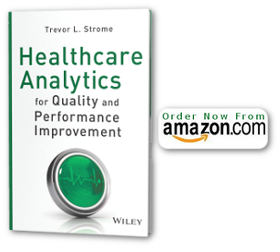Breaking the “reporting rut”
It is not uncommon for healthcare analytics professionals to fall into a “rut”. This happens when they confine their development and analytical activities to the toolsets/capabilities of one (or only a limited few) analytical applications. These ruts often stymie innovation, inhibit ongoing professional development, and most certainly result in organizations not obtaining full value from their data. All this negatively impacts on healthcare quality and performance improvement activities.
How does the “reporting rut” settle in? It often occurs simply by settling for existing (but sub-optimal) analytics functionality within a system. There are several comprehensive business intelligence (BI) packages common within healthcare, but despite the claims of the vendors, they don’t do everything exceptionally well. Many of these tools are great for for building dashboards, reporting, and relatively simple analytical applications, but they tend to be a bit weak on the statistical and advanced analytics components. It benefits healthcare analytics professionals (and healthcare improvement activities in general) to look beyond a single software tool or vendor and become familiar with several powerful tools, especially in the realm of more sophisticated analysis and data visualization.
Giving “R” a try
Although I regularly use one of the well-known BI suites, one of the tools that I have been using more often as I develop analytical applications for healthcare is “R” (website: http://www.r-project.org). R is a comprehensive system that is used by analytics professionals for statistical computing and visualizing data, and is actually used by scientists and analytical professionals from across the globe.
My experience is that R makes a great supplement to the larger BI suites, especially when augmenting the (sometimes lacking) statistical and data visualization capabilities of those BI suites. There are many tangible benefits of adding R to your analytical toolkit, some of which include:
- Open Source – this means that R can be obtained without cost for getting started (except for the learning curve), runs on a variety of platforms (including UNIX/Linux, Windows, MacOS), and has a wide variety of contributors.
- Comprehensive – R provides an amazing array of statistical and graphical techniques (such as linear and non-linear modeling, classical statistical tests, clustering, etc.)
- Strong graphical capabilities – R provides the capability to create publication-quality plots (with correct symbols and formulae)
- Extensible – R can be extended quite easily and as necessary by downloading and adding-on packages that cover many modern analytical and graphical techniques
Why Use R for Healthcare Analytics?
There are many reasons to give “R” a try. R will let you get closer to your data, and will provide many more analysis and visualization options than even many of the larger BI suites can. Also, in a tight fiscal environment, there is often little or no budget for the acquisition of new software tools; R is a very powerful tool that requires little investment up-front and can be expanded with new capabilities without incurring a steep cost.
There is a large community of R users on the internet; if you run into a problem, help is never that far away. Also, there are many books that have been written about the various capabilities of R, and how to get the most out of the tool. (Future blog postings will feature reviews of R websites, books, and other resources.)
Above all, if you are not already an R user, learning R will help expand your professional knowledge base and will provide a host of new tools and capabilities that will give your healthcare analytics a serious boost. I am not advocating moving away from the larger BI suites, as they have a very important role to play in ensuring that information is accessible to all who need it. I am advocating, however, for learning and experimenting with new tools that allow healthcare organizations to obtain even more value from the data they collect, and that will allow analytics professionals to expand their knowledge base, analytics competency, and creativity.
More R on the way!
This is the first in a series of articles on using R in healthcare analytics. The series will focus on how R can supplement existing healthcare analytics and business intelligence capabilities. Future articles will consist of tutorials/examples of how R can be applied to healthcare-related issues, as well as reviews of websites and books dedicated to R. Follow us by Twitter, RSS, and by email to stay up-to-date and receive notification of future articles.


{ 0 comments… add one now }